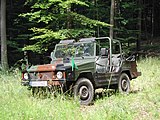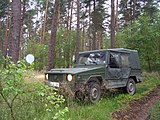VW polecat
| Volkswagen | |
|---|---|
|
VW Iltis standard version
|
|
| Polecat (type 183) | |
| Production period: | 1978-1988 |
| Class : | Off-road vehicle |
| Body versions : | Kübelwagen |
| Engines: |
Otto engine : 1.7 liters (55 kW) Diesel engine : 1.6 liters (52 kW) |
| Length: | 3972 mm |
| Width: | 1520 mm |
| Height: | 1837 mm |
| Wheelbase : | 2017 mm |
| Empty weight : | 1340 kg |
| Previous model | DKW Munga |
| successor | Wolf (vehicle) |
The VW Iltis (type 183) is an off-road vehicle that was part of the Bundeswehr fleet as a 0.5 t tmil lorry from the end of the 1970s to the end of the 1990s . It was also in use in various other NATO (e.g. Belgium) and non-NATO countries (in the mid-1990s, 175 vehicles from depot stocks were delivered to Lithuania).
Model history
General
The VW Iltis was not developed by Volkswagen in Wolfsburg, but by the Volkswagen subsidiary Audi in Ingolstadt and was also produced there. It was a replacement for the DKW Munga ("multi-purpose universal off-road vehicle with all-wheel drive"), the production of which at Auto Union ended in early December 1968. Before the first Iltis wagons were delivered, the Bundeswehr procured the VW Type 181 . The truck 0.5 t tmil gl ( 0.5 t payload, partially militarized, all-terrain) was used, for example, as a command and telecommunications vehicle, for the general transport of people, as a carrier vehicle for anti-tank weapons and for the makeshift transport of the wounded.
Before its market launch, a Iltis prototype was used as an escort vehicle together with sedans from Audi under winter conditions in Scandinavia during vehicle tests. The Quattro drive from Audi was inspired by the all-wheel drive system of the Iltis: Jörg Bensinger, then test manager and intellectual father of the Audi quattro , drove the Iltis during these tests and then suggested that the then head of Audi’s vehicle development department, Ferdinand Piëch , have an all-wheel drive Build road vehicle.
The polecat was also produced for the civilian market, but because of the high price it never reached a large audience. In 1982 the price of 39,300 DM was roughly three times that of a VW Golf with basic equipment. In today's currency and adjusted for inflation, this corresponds to a sum of 38,600 euros.
After production at Volkswagen was discontinued, the production line was sold to the Canadian company Bombardier , which manufactured the Iltis in a minimally modified form for the Canadian armed forces, among others. The Belgian army also obtained polecat from Bombardier; These vehicles were assembled with Canadian parts in the Belgian VW plant in Brussels and are in many respects more similar to the German Ur-Iltis than the Canadian. The German Bundeswehr replaced its Iltis vehicles with the Wolf gl , which is based on the Mercedes-Benz G-Class . Mercedes-Benz had already taken part in the tender with this type in the 1970s, but at that time it ended with the procurement of the VW Iltis.
body
The body was developed from that of the DKW Munga . The Iltis is an all-terrain vehicle with a box frame and Phaeton body (open with a folding top and four doors). The windshield can be folded forward. Initially buckling of the body under the A-pillar was remedied by an internal reinforcement plate. The tarpaulin cover and the removable (tarpaulin) doors enable use in both the open and closed position. The medical version was delivered with an extended canopy to enable the wounded to be transported lying down.
In front of the assembly area for the batteries under the rear seats, there is a cover plate that is stuck in front of the radiator grille as a baffle when driving through water.
Dimensions:
| length | width | height | |
|---|---|---|---|
| Standard execution: | 3972 mm | 1520 mm | 1837 mm |
| Medical version (extended hood): | 4540 mm | 1720 mm | 1855 mm |
Engine and drive
Is driven the ferret either a water-cooled four-cylinder - Otto engine ( Volkswagen EA827 engine ) in series construction with 1.7 liter displacement and 55 kW (75 hp), or in the construction years 1987 to 1988 from a turbocharged diesel with 1.6 liters and 52 kW ( 70 hp). The maximum torque is 140 Nm at 3000 min -1 . Around 880 units were manufactured by VW in Belgium exclusively for the German army. The poleces produced in Belgium at the same time were all powered by gasoline engines.
The VW model delivered to the Bundeswehr did not have a front differential lock, all other models could be delivered with such a lock. The vehicles have rear-wheel drive , the front-wheel drive can be activated. The differential lock at the rear and (if present) the front can be switched on manually, whereby the front axle can only be locked when the all-wheel drive is switched on. The four-wheel drive and the differential locks can be engaged at any speed. The front-wheel drive is integrated in the manual transmission. This has four synchronized forward gears as well as a reverse and an off-road forward gear, which are not synchronized. The briefly geared off-road gear can only be engaged when the front-axle drive (all-wheel drive) is engaged.
As with the Munga, the front and rear wheel suspensions are the same and, in the DKW tradition, are designed with wishbones at the bottom and wheel- guiding transverse leaf springs at the top. A rack and pinion steering is located on the front axle , at the rear the tie rods are mounted on the cross member of the frame above the springs.
The wheelbase is only 2017 mm; This means that the ramp angle is large and the risk of landing when driving over small hills is low. However, the driving comfort suffers; The vehicle reacts to bumps in rapid succession with strong pitching movements. The curb weight of the vehicle is 1340 kg.
Performance
The VW Iltis accelerates from 0 to 100 km / h in 21 seconds and reaches a top speed of 130 km / h. The low mileage is due to the relatively high vehicle weight and the high aerodynamic drag of the body.
The Bundeswehr recommends that its drivers only drive the vehicle with the front axle drive (all-wheel drive) engaged in order to increase driving safety.
Version comparison between Bombardier and Volkswagen
The differences between the early German model and the Belgian (some details were taken over with the turbodiesel built in Belgium):
- Dashboard displays for all-wheel drive and locks, with corresponding switches on the gearboxes
- Additional instruments for on-board voltage, radio battery voltage and cooling water temperature
- Front axle lock
- Side indicator
- modified wiring harness
- Antenna mount removed or changed on the left front fender
- at the right stern partly no screw holes for antenna brackets
- Changed spade mount under hood for US spade
- reinforced drive shafts all around
- standard axle lock at the front
- UNIROYAL T9 or MICHELIN X tires
- Plastic locking levers exchanged for metallic eccentric levers
- Doors have 2 zippers, the rear and lower edge of the pane
- rear doors have rectangular windows
- wide cooler
- Air-cooled distributor
- Jack screwed into the right storage box
- Body and frame screwed together with 6 instead of 4 rubber bearings
Motorsport
In 1980, all four VW Iltis started in the second Oasis Rally (today's Dakar Rally ) achieved top positions. The first place went to the Kottulinsky / Löffelmann team, whose winning vehicle with the starting number 137 is on display in its original condition in the Wolfsburg Automobile Museum. The other three teams came in 2nd, 4th and 9th. These results are also particularly worth mentioning because they were largely series vehicles.
literature
- Kai Sippel: VW Type 183 “Iltis” - the all-wheel drive off-road vehicle from Volkswagen 1976–1988 . Self-published , 2004, ISBN 3-00-014113-8 .
- Willy Queissner: VW Iltis . Schiffer Publishing Ltd, 2001, ISBN 0-7643-1309-6 .
Web links
- Volkswagen Classic dossier on the VW Iltis
- Bundeswehr Classix: The new Bundeswehr truck 0.5 t (1979) ( YouTube video of the Bundeswehr)
Individual evidence
- ↑ This figure was based on the template: Inflation was determined, has been rounded to a full 100 euros and refers to last January at the most









